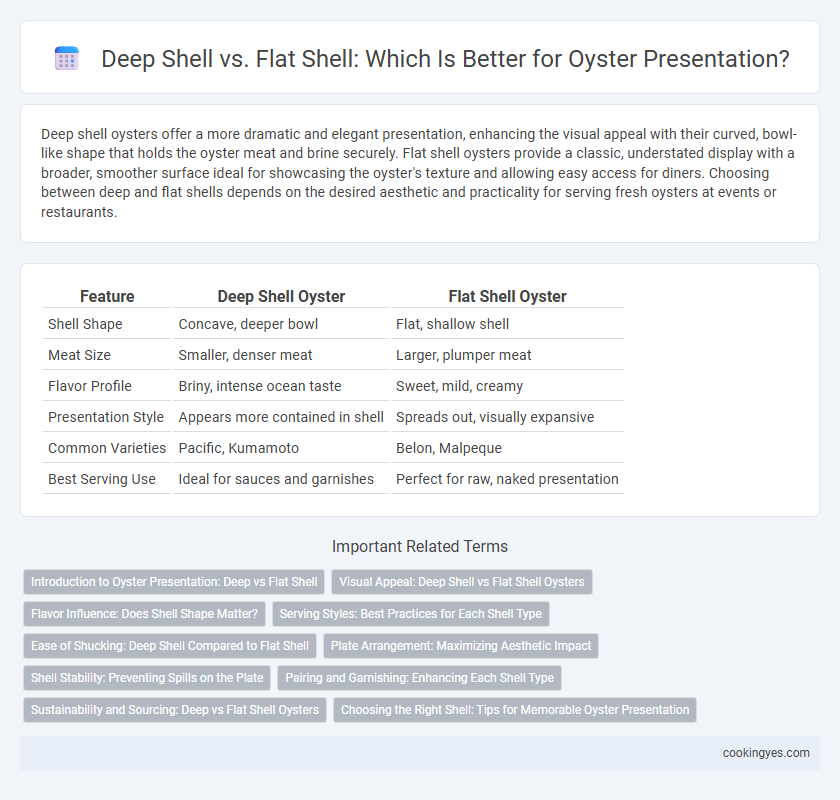Deep shell oysters offer a more dramatic and elegant presentation, enhancing the visual appeal with their curved, bowl-like shape that holds the oyster meat and brine securely. Flat shell oysters provide a classic, understated display with a broader, smoother surface ideal for showcasing the oyster's texture and allowing easy access for diners. Choosing between deep and flat shells depends on the desired aesthetic and practicality for serving fresh oysters at events or restaurants.
Table of Comparison
| Feature | Deep Shell Oyster | Flat Shell Oyster |
|---|---|---|
| Shell Shape | Concave, deeper bowl | Flat, shallow shell |
| Meat Size | Smaller, denser meat | Larger, plumper meat |
| Flavor Profile | Briny, intense ocean taste | Sweet, mild, creamy |
| Presentation Style | Appears more contained in shell | Spreads out, visually expansive |
| Common Varieties | Pacific, Kumamoto | Belon, Malpeque |
| Best Serving Use | Ideal for sauces and garnishes | Perfect for raw, naked presentation |
Introduction to Oyster Presentation: Deep vs Flat Shell
Deep shell oysters offer a more pronounced cup shape ideal for retaining natural juices, enhancing flavor intensity during presentation. Flat shell oysters present a wider, shallow surface that showcases the meat more prominently, creating an elegant visual appeal on the half shell. Selecting between deep and flat shells significantly influences display aesthetics and flavor perception in oyster service.
Visual Appeal: Deep Shell vs Flat Shell Oysters
Deep shell oysters offer a dramatic presentation with their robust, curved shape that cradles the meat, enhancing the visual depth and making them ideal for upscale plating. Flat shell oysters provide a sleek and minimalist appearance, showcasing the oyster's smooth inner shell and emphasizing the briny, glossy texture of the meat. The choice between deep and flat shells directly influences the aesthetic impact, with deep shells delivering a more substantial, rustic look, while flat shells highlight elegance and simplicity on the plate.
Flavor Influence: Does Shell Shape Matter?
Deep shell oysters often retain more briny, mineral-rich flavors due to their larger volume of seawater inside, enhancing the overall taste experience. Flat shell oysters typically have a cleaner, more delicate flavor profile influenced by their thinner shell and proximity to the water surface. Shell shape affects not only texture but also the subtle nuances in oyster flavor, making it a key factor in oyster presentation and selection.
Serving Styles: Best Practices for Each Shell Type
Deep shell oysters are ideal for serving on the half shell with ample cocktail sauce, allowing the oyster to rest in the curved basin, which prevents loss of brine and enhances flavor retention. Flat shell oysters are best presented with minimal garnishes on a bed of crushed ice to showcase their clean, crisp taste and firm texture. Serving styles emphasize the balance between preserving the oyster's natural juices in deep shells and highlighting the fresher, more delicate profile of flat shells through simpler presentation.
Ease of Shucking: Deep Shell Compared to Flat Shell
Deep shell oysters are generally easier to shuck due to their more pronounced hinge and thicker shell, providing a better grip and leverage for the knife. Flat shell oysters, often more fragile and with a flatter profile, require greater precision and care to avoid damaging the meat inside. This structural difference makes deep shell oysters a preferred choice for novices and high-volume shucking environments.
Plate Arrangement: Maximizing Aesthetic Impact
Deep shell oysters create a dramatic presentation by elevating the meat, allowing for layered plating that enhances visual depth and highlights garnishes like seaweed or citrus slices. Flat shell oysters offer a sleek, level surface that enables uniform arrangement in rows or grids, emphasizing symmetry and clean lines ideal for contemporary plating styles. Choosing between deep and flat shells directly influences the overall aesthetic impact, with deep shells favoring dynamic, sculptural displays and flat shells promoting minimalist, orderly presentations.
Shell Stability: Preventing Spills on the Plate
Deep shells provide superior stability for oyster presentation by offering a more secure and enclosed base, which minimizes the risk of spills or tipping on the plate. Flat shells, while more visually appealing for some arrangements, lack the depth needed to hold liquid and oyster meat securely, increasing the chance of mess during serving. Choosing deep shells enhances both functionality and customer experience by ensuring oysters remain intact and elegantly showcased throughout dining.
Pairing and Garnishing: Enhancing Each Shell Type
Deep shell oysters hold their briny, rich liquor better, making them ideal for bold pairings like mignonette sauces, cocktail sauces, or robust garnishes such as caviar and horseradish. Flat shell oysters have a delicate, briny flavor that pairs well with light, citrus-based garnishes like lemon wedges, cucumber vinaigrette, or a sprinkle of fresh herbs to enhance their subtle sweetness. Choosing garnishes that complement the liquor level and flavor intensity of each shell type elevates the overall tasting experience.
Sustainability and Sourcing: Deep vs Flat Shell Oysters
Deep shell oysters offer enhanced protection to the mollusk, supporting longer growth cycles and reducing environmental impact through sustainable aquaculture practices. Flat shell oysters, often sourced from wild beds, require careful harvesting techniques to prevent habitat disruption and maintain ecological balance. Sustainable sourcing prioritizes deep shell varieties for controlled farming, minimizing overharvesting and promoting oyster population resilience.
Choosing the Right Shell: Tips for Memorable Oyster Presentation
Deep shell oysters hold more briny liquor, enhancing flavor and visual appeal, making them ideal for elegant presentations. Flat shell oysters present a sleek, wider surface that showcases the oyster's texture and color, perfect for artistic plating. Selecting the right shell depends on the desired balance between flavor retention and aesthetic impact to create a memorable oyster presentation.
Deep Shell vs Flat Shell for oyster presentation Infographic

 cookingyes.com
cookingyes.com